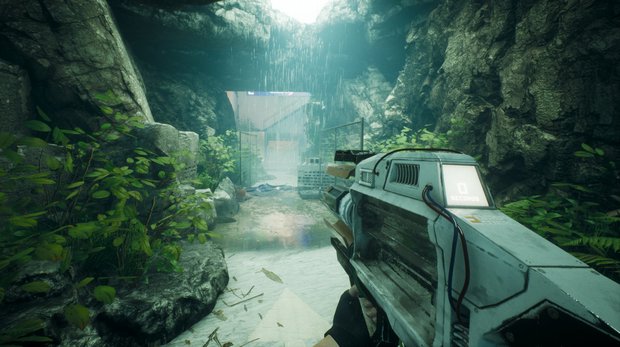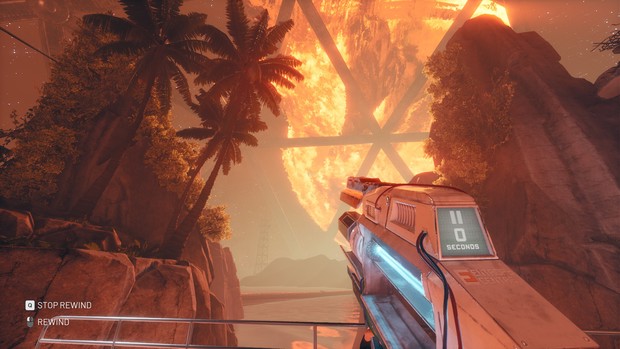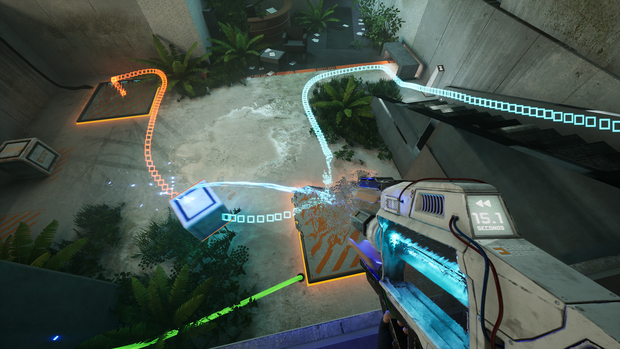The Entropy Centre review – Energetic physics puzzler largely measures up to its inspiration

- 0 Comments
Stop me if any of this sounds familiar: Your character wakes up in a small, closed room with no knowledge of who she is, and a disembodied robotic voice greets her with instructions on what she needs to do to get started with her laboratory puzzle routine. Once you manage to leave the room, you’ll discover that the facility appears to have been abandoned for quite a while. In the next twenty minutes, you’ll find your fancy physics gun, discover a specifically branded cube, and get started on some puzzle chambers, cheered on by a likable but somewhat tone-deaf AI, all while the building seems intent on falling apart around you. And that’s not even mentioning the laser cubes, light bridges, bounce pads, or that the lab has been repeating a certain action “nine, nine, nine, nine…” times. If imitation is the sincerest form of flattery, the Portal series is starting to blush.
It’s appropriate that The Entropy Centre from Stubby Games is about time reversal, because it does a fair amount of looking over its shoulder at the flagship of first-person physics puzzlers, but it does have its own ideas, so we’ll go ahead and shove that elephant out the back door so we can discuss the game on its own merits. In a lot of ways, it’s one of the better iterations of this kind of game, with cinematic set pieces, solid logic brain-teasers, and its own unique puzzle spin, but there are enough wrinkles in the design that I can give it only a qualified recommendation.
As I mentioned, you start without much information to go on, but it isn’t too long before you discover the purpose of this centre: being set up on the moon, it belongs to an organization tasked with the ordinary humdrum routine of sending the entire Earth back into the past every time there’s a world-ending catastrophe, which is quite often, as it turns out. They’ll undo the disaster and provide the world governments with enough data and warnings to allow them to avert the coming cataclysm. Plus, as a bonus, they’ll save an endangered species from time to time. At least, all of that is how it’s supposed to work. There’s nobody here now, you’re not sure who you are, the AI (a cheerful lass named Astra who talks to you as a smiley face inside your gun) is more or less just playing by the script, and the world you see out the windows seems a bit more molten than usual.
There might be something you can do about all this, but it will require a little more “entropy energy.” And the only way to increase that energy is to solve puzzles. Which is why this moon base is so gigantic. It’s filled with challenges for “puzzle operatives” to complete on a regular basis. Once they’ve run the gauntlet of these brain-teasers, they are handily time-reversed so that they can complete all the puzzles again with no memory of them. Collecting the energy requires that you don’t already know the answers, you see. Someday we’ll discover a sensible, narratively justifiable reason to solve a string of box-on-switch puzzles, but for now we must continue to suspend our disbelief.

Most of the gameplay is focused around these puzzle rooms and makes use of the central time-reversal mechanic. To get to the next room, you’ll need to manipulate various boxes to pressure plates both to unlock the door and get yourself to it. To aid you in this, your gun can reverse the flow of time for a single object, or set of related objects, like pieces of a crumbled wall or broken bridge. As a simple example, imagine a wide gap with a door on the other side. You’ve got a box and two buttons. One button extends a bridge across the gap, the other unlocks the door. If you place the box on the unlock switch first, then the bridge switch, you can cross the bridge, use your gun to reverse the box back onto the unlock button, and exit the room. Most of the puzzle solving is some variation of that kind of logic.
The mechanic is pretty fun to work with, particularly in the few instances where objects are getting launched into the air or colliding with things, but I often had the feeling that it wasn’t being utilized to its full potential. For too many puzzles, the solution was simply to figure out where boxes needed to be and in what order, then put them there in the reverse order. When you’re sending them back in time, there’s a nice energy effect coming from the gun, and something like a dotted line that indicates the object’s path, but watching the boxes wiggle awkwardly through the air on the path I’d previously carried them didn’t seem as, well, time-bendy as I would have liked. I wanted to feel more like I was playing at the extreme edges of physics and less like I was writing a programming script backwards.
Similarly, while I appreciated the steady drip of new puzzle mechanics as the levels progressed, only a few of the additions seemed to interact meaningfully with the time mechanic in a way that made me have to think about them differently. For example, there’s something called the “tall box” that is basically, you know, a tall box that starts out collapsed. When you rewind it, it reassembles itself into its intact form. It’s essentially little more than a remote-triggered mechanical lift, and tends to add little to the problem-solving experience. Likewise, various other kinds of objects, like laser cubes and light bridges, might give you more ways to navigate the space or activate switches, but they don’t do anything fundamentally different than the regular cube when it comes to reversing them in time, so encountering them doesn’t much change how you go about solving a room.

One other issue related to the puzzle design is the accuracy of the controls. While the first-person navigation, handled with mouse and keyboard or controller, feels just fine as you’re walking through the halls and jumping onto ledges, some of the puzzles require a degree of precision that feels frustrating, particularly when it comes near the end of a long puzzle sequence. More than a few times, I would be one step away from the exit door of an intricate room, but that final step was to jump off a platform, land on a small bounce pad, and be launched up to the final ledge. A neat idea in theory, but it feels like leaping off a building to land on a postage stamp. The sinking feeling of landing just to the side of the pad was not unlike seeing the last domino of a chain reaction fail to topple. The only way forward is to go through all the motions of manually resetting the room’s components so you can navigate back to the ledge and give it another try. If only you could rewind your own mistakes.
Despite these caveats, the puzzles are still generally enjoyable to work through. In particular, the ones towards the end were my favorites, combining all of the ingredients in interesting ways to cook up some complex puzzles that are challenging without being overly difficult. But I actually felt the game was at its most engaging in the spaces between the puzzle rooms. I don’t know why the base needs to be as large as it is, with enormous concrete rooms, sprawling atriums, endless offices, and a surprisingly large number of artificial beaches, but the scale of it all is impressive and, while not exactly next-gen in terms of graphical fidelity, uses the Unreal engine to good effect, with fairly realistic textures, water ripples, and a hazy mix of light and shadow. Walking past beach umbrellas on a simulated seashore bathed in orange light, watching the water shimmer as it reflected the light of the Earth burning to a crisp outside the window, produced a striking mixture of beauty and existential dread.
These in-between sections are more than just for sight-seeing, though. Other than some backstory and other bits of flavor text in the form of emails scattered across computer terminals (which are inexplicably outdated given that it’s a state-of-the-art technology centre that was supposedly active throughout the 2020s), this is also where you’ll encounter the bulk of the more cinematic gameplay set pieces. You’ll time-reverse crumbling structures, worm your way through the industrial infrastructure, and even engage in combat with the security robots by reversing their energy projectiles back into them. The action elements take center stage during these sections, to very divergent results—they were some of the best and worst moments in the game.
On the positive side: climbing up a rapidly flooding stairwell while reversing falling walkways and pillars to create bridges in the air as the normally subdued sci-fi synth-pad music gives way to a driving, thudding electronic beat. There are a few sequences like this, and they’re an exciting change of pace that amps up the energy. Sure, I died a few times, but these scenes are relatively short, so you’re only set back a minute or so, and they’re fun enough that I was always ready for another try. The time mechanics really shine here in a way that I wish they did more often in the puzzle rooms.
Sadly, the temporal combat sounds like a great idea, but in practice is one of the most frustrating bits of design that I came across. It’s simple enough in small doses to dispose of some semi-cute robotic sentries that look like an old TV set. But imagine being surrounded by a squad of these machines that are constantly firing at you while you try to carry out a string of mundane tasks and simple puzzles. Did I mention that their projectiles home in on you, that you are completely defenseless while you’re holding boxes or rewinding other objects, that if you die you have to start the whole string of tasks over, and that the robots are endlessly respawning, so even if you do destroy a few, they will immediately send in others in their place? Well, consider it mentioned. After dying several times in one of these scenarios, I nearly rage-quit. Fortunately, the hardest of these are actually in the middle of the game, and they let up considerably after that.
There is frequent dialogue between your player character and the AI lurking in your gun, and while the humor can sometimes be a little contrived, the voice acting is solid and there’s enough charm to be lightly endearing, even though it had the unfortunate side effect of making me remember what a great character GLaDOS was in Portal – which, in case you forgot, this game isn’t. The story kept me engaged, though, and I was motivated by finding out what was going on, but the middle part of the game sagged and nothing much happened for a few hours. It picks back up towards the climactic end, which is great to look at and fun to play, even though the plot at this point is a little predictable and your relationship to the AI is a bit too sentimental. Still, it’s effectively and stylishly wrapped up, nearly making me forget some of the frustrations along the way.
Final Verdict
Is it Portal 3? No. But despite the obvious parallels, The Entropy Centre does bring its own ideas to the table. The time mechanics, while they could have been fleshed out in more surprising or mind-bending ways, are a treat to play with, particularly in the more cinematic scenes. The two main characters have a good repartee, and the narrative has its memorable moments and leaves plenty to ponder. Despite a few frustrating design issues, there are plenty of solid head-scratchers and engaging action sequences that generally get better as the game goes on. If you’re a puzzle fan and can handle some occasionally tricky first-person maneuvers, you’ll likely enjoy the ride. But if you’re hoping to experience something on par with Portal, this game will frequently remind you of the past, but it won’t quite take you there.
Hot take
As another iteration on the futuristic physics puzzler, The Entropy Centre is one of the better ones, but a few uninspired design elements and some frustration with controls holds it back from being a real classic.
Pros
- Cinematic set pieces use the time mechanic well
- Puzzles are logical and at just the right difficulty
- Story is intriguing and your AI companion is charming
- The environment and sci-fi effects are great to look at
Cons
- Sticks a bit too close to Portal as its inspiration
- Some of the added puzzle elements are a little dull
- Controls can cause frequent mistakes that will cost you time
- Combat is poorly executed and frustrating
Brian played The Entropy Centre on PC using a review code provided by the game's publisher.

- Advertisement
- Help support AGH by advertising with us











0 Comments
Want to join the discussion? Leave a comment as guest, sign in or register.
Leave a comment